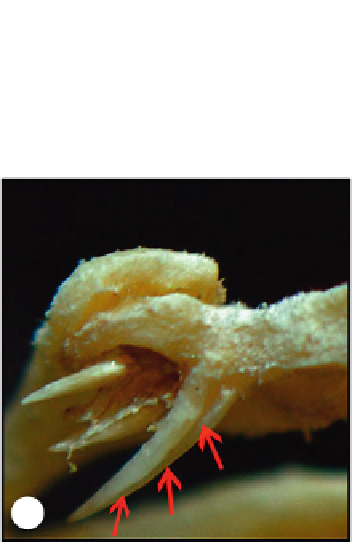Biology Reference
In-Depth Information
(C)
(D)
Plate 4.7
(C) Lateral upright view of posterior maxilla of
Boiga dendrophila
.
(D) Close-up of enlarged posterior maxillary teeth of
Boiga dendrophila
.
The
posteriormost maxillary teeth are notably enlarged, recurved, and deeply grooved (arrows).
Plate 4.7C and D, AMNH specimen #R73608, photos copyright to Arie Lev.
(F)
(E)
Plate 4.9
(E and F) Close-up of enlarged maxillary teeth of
Boiga irregularis
.
The
posteriormost maxillary teeth are notably enlarged, recurved, and deeply grooved (arrows).
Plate 4.9
E and F, AMNH specimen #114498, photos copyright to Scott A. Weinstein.
cells and were composed of columnar cells, but in
B. blandingi
there were mucous
cells associated with the glands. A lumen was noted in
90% of the tubules of the
B.
dendrophila
and
B. d. latifasciata
Duvernoy's glands, but in only 10% of the tubules
of the glands from
B. blandingi
(Taub, 1967).
4.2.1.2 Summary of the Toxinology and Properties of Duvernoy's Secretions
from
Boiga
spp. (Excluding
B. irregularis
)
There is relatively limited information regarding yield and toxicity of Duvernoy's
secretions from these species (see Appendix B). Weinstein and Smith (1993) reported
a yield of 147.5 μL (1.6 mg solids) from
B. blandingi
. The protein content of secretion





